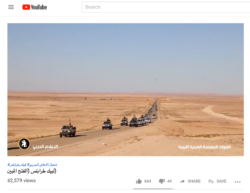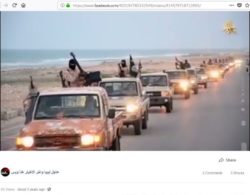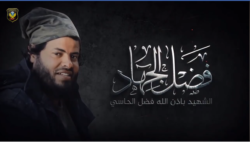By spring 2019, Sputnik had published approximately 700 articles on the Egyptian site, far more than any other contributing source. Appearing as a translation or reprint of concurrent material on Sputnik.com or RT.com, the relatively brief articles typically addressed geopolitical issues of interest to Russian policies in the Middle East. Every article generated a common number of LinkedIn followers and would be quickly reposted across a range of nondescript blogs and forums. This strategy was effective in helping drive traffic to the Kremlin-backed sites, using what researchers describe as a “ping pong” effect in which the “coordinated use of complementary websites” serves to “springboard a story into mainstream circulation.”
Russian efforts to embed and normalize the consumption of Kremlin-based media in the digital ecosphere of the Arab world have been increasing for years. Russia, of course, is not alone in this game. But Russian efforts have been particularly successful of late. RT Arabic currently ranks among the top three “most-watched news channels in six Arabic countries [Egypt, Morocco, Saudi Arabia, Jordan, the UAE, and Iraq]” according to a 2015 Nielsen poll. The regional consumption of Russian-state media on the whole may be even more substantial than the TV ratings indicate in part because the sheer quantity of content spread by RT and Sputnik across social media dwarfs its competition. In 2018, Arabic.RT.com was the highest ranked news organization in virtually every Arab country, according to Alexa indexing. In Egypt, RT ranked some 248 points above its nearest competitor Al-Arabiya.
Russian-style influence operations are also being replicated throughout the Middle East and North Africa. In August 2019, Facebook announced the discovery of nearly 3,000 false and misleading posts linked to hubs in the United Arab Emirates, Egypt and Saudi Arabia. The posts deployed what Facebook describes as “coordinated inauthentic behavior,” a strategy comparable to ping-ponging in which “groups of pages or people work together to mislead others about who they are or what they are doing.”
Yet while the strategic deployment of misinformation has effected virtually every major flashpoint in the Arab world, the phenomenon has become particularly acute in the context of the current battle for the Libyan capital of Tripoli—which pits the Libyan National Army (LNA) and its supporters in Russia, Egypt, Saudi Arabia, the United Arab Emirates (UAE) and France against the Government of National Accord (GNA) whose backers include the United Nations (UN), Great Britain, Italy, Qatar and Turkey. While this information war has included most major Arabic-language state-based media outlets, RT appears by far to be the most influential generator of content, with Russia mobilizing immense amounts of black and grey propaganda on behalf of the LNA and its shadowy leader Khalifa Hifter.[1]
Russia’s digital interference into the Libyan civil war provides a snapshot of both the Kremlin’s growing clout within the region’s information ecosphere and its sophisticated operational methods. Working through a synergistic network of media outlets, bots and willing partners, Russian information operations seek to shape public perception by influencing the socio-emotive or narrative contours of the conflict through a neatly delineated set of antagonists and protagonists, culturally loaded signifiers and an implied resolution: that stability may only be achieved through absolute capitulation by the losers or complete triumph by the victors. From Syria to Egypt, Sudan and Libya, the growth in Russian-backed information operations illustrates the degree to which information manipulation has become central to the Kremlin’s bid to reshape the regional order, empowering authoritarian regimes and elevating hostility against the twin demons of political Islam and Western liberalism.
Russia’s Influence Strategy Reaches Libya
Russian influence strategies targeting both political Islam and Western liberalism began early in the 2011 Arab uprisings. On January 31, 2011, WikiLeaks provided The Daily Telegraph with a stolen US State Department cable published under the headline “Die Hard in Derna.” The otherwise unassuming cable written by the former US Ambassador to Libya Christopher Stevens discussed Stevens’ attempts to improve the economy in Derna, widely seen as a haven for Islamic extremism. Following Stevens’ murder in 2012, the article was promoted by alt-right news outlets including Front Page Magazine in the United States as evidence that the Ambassador’s death was the result of “feeding the crocodile.”
Spread across Arabic and English-language social media by a small army of bots and ultimately translated and published verbatim in ‘Amr ‘Ammar’s monumental 2014 conspiracy-theory book The National Humiliation, the Front Page Magazine article falsely claimed that the memo provided evidence the Obama administration had been complicit in the region’s growing wave of Islamization. The primary target of this operation appeared to be the Egyptian public, where the official launch of the Tamarod campaign—the military-backed popular mobilization against the new Muslim Brotherhood government in Egypt—was just months away. But the attempt to link Islamism in Libya to the United States became a powerful vector of influence in the battle for Libya as well.
Russia had already designated the Muslim Brotherhood a terrorist organization a decade before the label was adopted by countries like Syria, Egypt, Saudi Arabia, Bahrain and the United Arab Emirates. Strongman regimes with policies deferential to Russia typically provided the counterpoint to this antagonism against Islamism, though Russia itself at times appeared as the hero in the story, particularly in the context of the war on ISIS.
But in the context of Libya, Russia’s intervention into the information ecosphere has paralleled the rise of Khalifa Hifter, who returned to Libya shortly following the 2011 uprising against the regime of Muammar al-Qaddafi. Initially appointed Field Marshall of Libya’s National Transition Council, Hifter subsequently broke from the Islamist-led Dawn party in Tripoli following their alignment with Misrata-based militia forces in 2014. The extension into Libya of ISIS aligned militias in 2014 helped consolidate Hifter’s own self-narrative as the last-best defense against the rise of militant Islam. Compounded by Egyptian, Russian and Saudi media portrayals of the GNA in Tripoli as being weak if not complicit in the face of jihadism, Hifter’s narrative has gained increased traction over the past five years. Now, as the two sides’ face-off over Tripoli awaits an uncertain resolution, greater understanding of the communicative dimensions of this conflict has gained increased urgency.
Manufacturing Hifter
Khalifa Hifter’s rise to prominence is one of the more unusual phenomena of the Arab uprisings. A former officer in al-Qadhafi’s regime, trained in Russia and ultimately captured in Chad in the late 1980s where he had joined forces with the CIA-backed National Front for the Salvation of Libya, Hifter was living in exile in Northern Virginia when the Libyan uprising began in February 2011.
The media narrative surrounding the announcement of his first major campaign codenamed Operation Dignity was contentious from the start. Presenting himself in full military adornment, his torso positioned roughly before the Gulf of Sidra—the lifeline to Libya’s oil production—al-Liwa’, or Major General as he was then known, asserted that his plan to withdraw from the UN-sponsored National Conference and to “cleanse” the country of “terrorists” was not the beginning of a “military coup” but rather the natural evolution of his “popular mandate.”
Many observers remained unconvinced by this rhetorical dance. They saw the launch of Operation Dignity as the beginning of precisely what Hifter had said it was not. Al-Jazeera, for example, published a story with the headline: “Hifter’s Coup: Real or Media Spectacle?” in which the GNA’s head of security in Tripoli asserted that the timing of Hifter’s announcement—on the eve of the third anniversary of the 2011 uprising and at the same time as demonstrations were scheduled to follow Friday prayers—echoed the Egyptian scenario which also began by way of a “Television coup.” Hifter’s claim to a “popular mandate” resembled the rhetorical strategy of al-Sisi’s claim that ousting Egypt’s then-leader Mohamed Morsi from office on July 1, 2013 was not a military coup per se but rather an expression of “the people’s will.” Hifter’s Operation Dignity had no comparable populist Tamarod campaign but his direct replication of al-Sisi’s rhetoric signaled a clear affinity with the Egyptian strongman as well as the emergence of a powerful new alliance with Egypt on Libya’s post-revolutionary landscape.
RT, along with other major Arabic-language outlets such as Al-Arabiya (Saudi) and Youm 7 (Egyptian) and local networks like Libya al-Ahrar moved quickly to counter the narrative that Hifter was a renegade warlord who aspired to become “Libya’s next dictator.” Attempts to manufacture Hifter’s image as a force of stability and beacon of anti-terrorism have since assumed several dimensions.
On one hand, a relentless discourse on the need to bring order to Libya’s chaos—propagated chiefly by Hifter’s camp and magnified through major media outlets like RT and anonymous blogs—has effectively saturated the media sphere with the narrative of chaos and the necessity of using force rather than diplomacy to restore order—precisely Hifter’s own self-narrative.
On the other hand, Russia has conducted major information operations during Hifter’s ongoing military campaigns, coming to fruition with Hifter’s assault on Tripoli in April 2019. Examining a fifteen-day period during the launch of the LNA’s assault on Tripoli, researchers with the Centro Studi Internazionali (CSI) in Rome found that Arabic.RT.com had over 263,000 “interactions” drawn from material related to the leader of the LNA, Khalifa Hifter. Moreover, RT trailed only YouTube in terms of the online domains most commonly shared across relevant Twitter messaging. Equally notable, the CSI found a pattern of “interconnected” and “automated informative blogs” strategically coordinated to saturate the media environment with news pertaining to Khalifa Hifter. While it is not clear whether the campaign is being coordinated by one or more state entities, the CSI was able to track the ownership of two blog platforms to an individual in Saudi Arabia—a strategy that mirrors the Kremlin’s technique of “ping-ponging” as seen in the Egyptian media sphere.
More visibly still, Russia has networked with broader regional supporters within the greater communications sphere of the pro-Hifter camp who regularly contribute to the LNA’s narrative identity. In early May, 2019, for example, the Saudi flagship station Al-Arabiya ran a report about recent video footage purporting to show an Iranian weapons shipment arriving at the port of Misrata. This was followed by a report on May 21 that “Turkish ships… carrying large numbers of terrorists, including among them supporters (ansar) of Da‘ish” were debarking at the port of Tripoli. And on May 31, citing an article in Jeune Afrique, Al-Arabiya ran a headline story stipulating that the leader of ISIS—Abu Bakr al-Baghdadi—may have sought refuge in Libya.
For its part, RT has aired reports like that on April 30 in which a London-based “expert” rehashes Hifter’s law and order narrative within a split screen showing scenes of an LNA military parade (also featured on the LNA’s Facebook page) juxtaposed with an apparent terrorist assault on an unnamed government compound. The former is orderly, decisive and carefully choreographed. The latter is chaotic. These kinds of communicative aesthetics smartly reinforce the pragmatic dimensions of Hifter’s movement but they are also “permutative” in Philippe-Joseph Salazar’s terms, that is: automatically tied to, and ironically reliant upon, the very material they seek to supplant.
Contradictions of the LNA’s War Information Division
The permutative, or derivative quality of the anti-ISIS messaging campaign surrounding the LNA’s assault on Tripoli is even more apparent in the group’s own propaganda, especially the dramatic two-and-a-half-minute video distributed via social media on April 5, 2019.
Tactfully released after the LNA’s successful establishment of a forward operating base just south of Tripoli, the video “Al-Fath al-Mubin” was ostensibly created as the principal propaganda piece for the LNA’s imminent assault on the capital. Named in homage to the campaign of ‘Amr ibn al-‘As—the seventh century general who led an effort to open the Maghreb after the Muslim conquest of Egypt in 641 C.E.—the phrase Al-Fath al-Mubin carried broad cultural currency in part because of its association with a popular Egyptian musalsala (telenovela) of the same name from the early 2000s. Invoking the story of the sahab (companion) of the Prophet, Ibn al-‘As, also appeared calibrated to rally the significant faction of Salafist fighters enlisted in Hifter’s campaign. Vying for the attention of this critical population may also have contributed to the LNA’s use of ISIS-style cinematography.

Figure 5. “Al-Fath al-Mubin,” 2019. The War Information Division. Facebook.com

“Ghazwat Abu Ibrahim al-Masrati,” 2015. Al-Furqan Media Foundation / Wilayat Tarabalus. Facebook.com
Al-Fath al-mubin features a massive convoy of heavily mounted pick-up trucks streaming down a highway in a way resembling scenes from ISIS videos like the 2015 release Ghazwat Abu Ibrahim al-Masrati (The Expedition of Abu Ibrahim al-Masrati) which documented the invasion of Sirte, Libya by various ISIS aligned militias in the spring of 2015. The original scene—most-likely produced by Al-Furqan Media Foundation (the principal filmmaking unit of the Islamic State) and disseminated under the Wilayat Tarabalus (State of Tripoli) banner—became a ubiquitous part of ISIS’s Libyan messaging strategy. Beginning with the horrific filming of twenty-one Egyptian men simultaneously executed on the shores of Sirte, this scene invoked a sense of imminent arrival and holy war.
Employing a similar arsenal of aerial-drone footage, stop-motion photography and graphic design software, the al-Fath al-mubin video was part of a broad effort by the LNA and its War Information Division to imitate and presumably counter the aesthetic appeal of ISIS communications. This effort included stylized battle scenes in the tradition of ISIS’s ghazwa or military expedition genre; homages to fallen martyrs; and video exposés of “treacherous” enemies. The LNA’s War Information Division even employed mythico-aesthetic tropes similar to those invoked by ISIS and other Salafi-jihadist organizations such as the image of the lion and audio-cuts of drawn swords.

War Information Division. “The Martyr Fadl al-Jasi.” 2018. Facebook.com

War Information Division, “The Martyr Fadl al-Jasi.” 2018. Facebook.com
The dissemination of the al-Fath al-mubin promotional video appears to have been successful: Following its release, various armed militias in and around Tripoli took to the Internet to declare their allegiance to Hifter. Thousands of ostensible news stories, the vast majority of which derived from anonymous blogs, flooded the Internet with images of the video. While it was difficult to verify the timing and authenticity of these postings, the combined effect of the media assault was one of coordination and convergence.
Yet the derivative quality of the aesthetic underpinning this narrative—from the Salafist overtones to the ISIS-style cinematography—also helps sustain the very opposite of what it seeks to eliminate. Islamist factions can play this game too. Unlike the LNA however, theirs is crafted from a deeply rooted ideology that inherently absorbs the Russian-Arab securitization narrative as a device of absolute hostility.
Arguably the most profound critique of Hifter’s campaign, in qualitative if not quantitative terms, has flowed not through the UN or oppositional news outlets like Al-Jazeera or BBC, but al-Tinahsa—the small but mighty Salafist news organization built around the authority of Sheikh Saddik al-Ghariani, Libya’s Grand Mufti and head of the Office of Fatwas. While Al-Ghariani has at times defended but has also urged groups like Ansar al-Sharia to recognize the Islamist-linked government in Tripoli, he has been unequivocal in his condemnation of Hifter. As he proclaimed bluntly on April 10, 2019: “Hifter with his Zionist project kills for the sake of the devil.” His condemnation of the Liwa’ stems not simply from the perception that Hifter is doing the bidding of hostile outsiders, but also that he is acting beyond the shores of the collective will. The “legal duty” (al-wajab al-shari‘i) of every Libyan he exclaimed in abstract terms was to “speak with one voice.” The Liwa’ represented a source of division. His campaign to secure the country was in fact pulling it apart.
Russia’s Infowar Endgame
Russian information operations in Libya ostensibly mask a more pragmatic push for influence in a country with the largest known oil reserves in Africa. Yet apart from the prospect of limiting or diverting Libyan oil production to places like China—two developments that would empower demand for Russian and Gulf exports—the most compelling rationale behind the formation of a Russian-led interference front in the battle for Tripoli is arguably ideological. Russia and its allies in this struggle share an almost visceral disdain for the global project of political Islam. For the Gulf regimes and Egypt, the threat of ‘al-jihadiyya wa al-ijtihadiyya’ (jihad and ijtihad) is seen as existential insofar as the populist underpinnings of the movement pose a direct challenge to the autocratic foundations of their authoritarian rule.
For Russia, the fight against Islamism, in all of its shades, has become a veritable raison d’être in what has been described as Putin’s mission to present himself as a Tsar Nicholas I-like champion of “Orthodoxy, Autocracy, and Nationality” around the globe. Russian support for Hifter—who traveled to Moscow multiple times in advance of the Tripoli offensive—mirrors the Kremlin’s alliance with far-right nationalist movements in Europe and elsewhere insofar as the campaign challenges the durability of democracy as a viable model for long-term stabilization. The fact that Hifter has also been waging a brutal war against ISIS in Libya, or that the GNA includes former members of al-Jama‘a al-Libiyya al-muqatala (Libyan Fighting Group, LFG) that was once aligned with al-Qaeda, muddies the waters for third party players like France and the Trump administration which recently endorsed Hifter. But Russia’s long-term project for the Middle East and North Africa remains undiminished: to roll-back Islamism and to maintain in power military regimes with material if not cultural ties to Russia.
While the rhetoric of being the only alternative to destabilization has served to empower a host of pro-Russian leaders around the globe (from Syria to Hungary, Venezuela and the United States), the Libyan scenario delineates a possible inflection point in this trend. Predicated on techniques of aesthetic replication, automated dissemination, emotive rhetoric and misinformation, while deftly effective in manipulating public discourse, these tactics are also strategically shallow, designed to dilute the authenticity of information while expanding its reach. Misinformation in this way can allow any number of social movements whose ideology may or may not align with the objectives of the initiating party to gain purchase.
Along with the recent spectacle of Trump endorsing Hifter (and thereby affixing the perennial stigma of US influence to his campaign) the permutative quality of the LNA’s counter-communications strategy is likely to only reinforce the legitimacy of Islamist voices like Ghariani or indeed even al-Qaeda. A long-term presence of militant Islamism in Libya that disrupts oil production or continues to destabilize the country to the benefit of competing oil giants, however, may be more strategically desirable to the Kremlin than we have yet to realize.
Endnotes
[1] Abigail Hauslohner and Sharif Abdel Kouddous of The Washington Post discovered that Hifter had voted while in Virginia. He spelled his name: “Hifter.”
